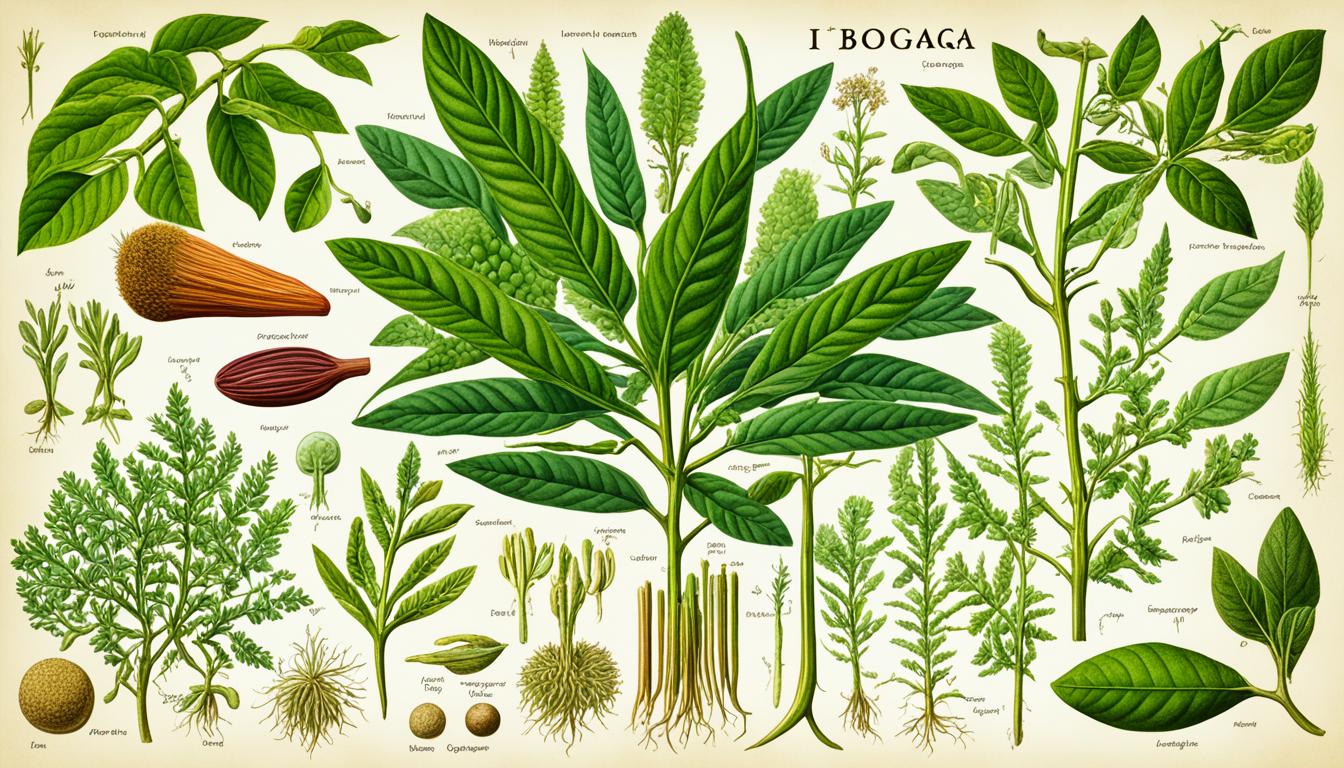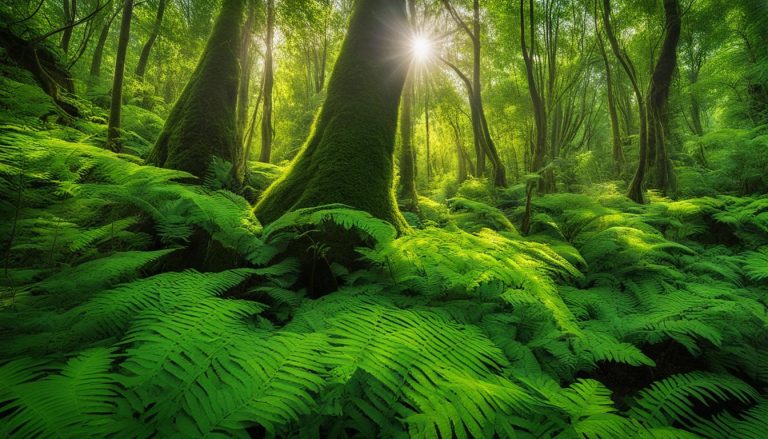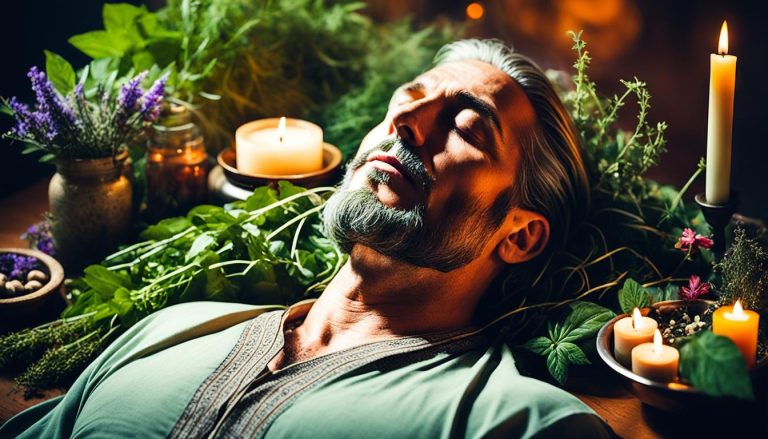What Plants Contain Ibogaine?
The quest to understand what plants contain ibogaine leads us into the heart of the Apocynaceae family, where nature harbors potent psychoactive substances. Ibogaine, particularly celebrated for its visionary potency, has intrigued minds seeking both knowledge and healing. The primary source of natural sources of ibogaine is the famed iboga plant. Its root bark is esteemed among practitioners and researchers for its significant ibogaine content. But beyond iboga, other ibogaine sources in nature echo its psychoactive legacy. The grasp of Voacanga africana and Tabernaemontana undulata within the realm of psychoactive flora illustrates nature’s complex chemical tapestry. Despite the controversy and the oscillating waves of legality and acceptance, the story of ibogaine invites us to delve deeper into the mysterious interplay between plants and human consciousness.
Key Takeaways
- Tabernanthe iboga stands as the paramount ibogaine-containing specimen.
- Voacanga africana and Tabernaemontana undulata are notable for their varied psychoactive alkaloids.
- The unique attributes of each plant contribute distinctly to ibogaine’s extraction and application.
- Despite the therapeutic potential, users should approach ibogaine with awareness of its legal and safety considerations.
- In-depth exploration is vital in understanding the psychoactive effects and potential of ibogaine.
- The relationship between traditional use and modern scientific discovery shapes our comprehension of this potent alkaloid.
Understanding Ibogaine: A Detailed Overview

Ibogaine is a natural psychoactive substance derived from ibogaine-containing plants. Its role in traditional rituals and potential therapeutic applications has sparked a growing interest in its unique alkaloid profile and psychoactive effects. At the heart of its mystery and allure is the complex nature of ibogaine alkaloids, which invite a deeper exploration into their properties and uses.
The Psychoactive Properties of Ibogaine
The quest to understand the psychoactive effects of ibogaine takes us to the root bark of the iboga tree, or Tabernanthe iboga. Native to Central Africa, this tree’s powerful alkaloids induce a visionary phase, enabling deep psychological and spiritual experiences. Those who embark on an ibogaine journey report a period of introspection, often revealing insights that aid in personal growth and healing.
Historical Use and Modern Discovery
While modern science has only recently acknowledged the psychoactive effects of ibogaine, the iboga plant has been a cornerstone of African spiritual practices for centuries. Indigenous communities understood the profound impact of these plants with ibogaine alkaloids, using it to facilitate visionary states and as a tool for healing. Discovered by the Western world in the early 20th century, ibogaine has since been studied for its potential to disrupt patterns of addiction, offering hope to those seeking liberation from substance dependence.
Extraction and Chemical Structure
The complex chemical structure of ibogaine features two chiral centers, a hallmark of its intricate molecular composition. The process of ibogaine extraction requires specialized knowledge and sophisticated synthesis methods to isolate the alkaloids from other compounds. It can be extracted directly from ibogaine-containing plants like the iboga tree or, alternatively, synthesized from related compounds such as voacangine. As researchers continue to unravel the secrets of ibogaine’s structure, new possibilities emerge for its application in medicine and therapeutics.
Ibogaine-Rich Plants of the Apocynaceae Family
Within the diverse Apocynaceae family, a trio of plants stands out for their significant ibogaine content. These botanicals are not just remarkable for their psychoactive effects but also for their potential medicinal applications. Among them, Tabernanthe iboga, Voacanga africana, and Tabernaemontana undulata are particularly noteworthy for being natural ibogaine-rich plants sourced throughout the tropics. Here, we will delve into the profile of each, exploring their alkaloid composition and relevance in both traditional and contemporary contexts.
The Iboga Plant Composition and Alkaloid Content
The revered Tabernanthe iboga, indigenous to the Congo Basin’s lush forests, is perhaps the most well-known among ibogaine-containing flora. Its root bark is a cornucopia of alkaloids, with ibogaine being the most abundant, accounting for nearly 80% of its alkaloid framework. This concentration makes Tabernanthe iboga a powerhouse in the realm of psychoactive and therapeutic botany.
Voacanga Africana: Lesser-Known Ibogaine Source
Sharing its tropical African origins with Tabernanthe iboga is Voacanga africana. While it harbors a lesser-known profile, it similarly contains a spectrum of psychoactive alkaloids, with ibogaine being present albeit in lower quantities. This plant is also the source of voacangine, an alkaloid that’s chemically related to ibogaine and contributes to its psychoactive repertoire.
Tabernaemontana Undulata: Amazonian Ibogaine Plant
Extending the reach of ibogaine-rich species to the Amazon Rainforest is Tabernaemontana undulata. This botanical relative shares a kinship with Tabernanthe iboga and possesses ibogaine within its roots. The presence of ibogaine in the flora of such varied climates underscores its adaptability and the widespread intrinsic value these plants hold.
Spanning continents and climates, these ibogaine-rich plants are cherished not only for their natural bounty of alkaloids but also for their cultural and potential therapeutic roles. As researchers continue to explore the psychoactive landscape, these members of the Apocynaceae family remain at the forefront of scientific and botanical interest.
Geographical Distribution of Ibogaine Containing Plants
Exploring the world in search of the elusive ibogaine leads us to vibrant tropical regions, each with its unique ecosystem that supports the growth of this potent substance. To understand where to find ibogaine in plants, one must look to the humid and shaded groves of Central Africa, where the iboga plant is deeply entwined with both the ecology and cultural fabric. Here, the Tabernanthe iboga flourishes, its roots rich with a considerable ibogaine content, sustaining the traditional medicinal practices that have revered this plant for generations.
In the search for plants used for ibogaine extraction, the African continent reveals more of its botanical assets. The Voacanga africana scatters across the tropical zones, marking its presence with a lower yet significant level of ibogaine. Traversing to another part of the globe, the Amazon Rainforest echoes this richness with its own ibogaine harbinger, the Tabernaemontana undulata, thriving amidst the dense and biodiverse Amazonian backdrop.
Understanding the iboga plant ibogaine content and its natural origins allows for a deeper appreciation of these plants and their value to both indigenous cultures and potential scientific applications. As explorers of botany and seekers of healing properties, we are reminded of the delicate balance between these plants and their native terrains—a relationship that is vital for their continued existence and availability for ibogaine extraction.
The Therapeutic Uses of Ibogaine Throughout History
The profound psychoactive properties of ibogaine have transcended centuries, evolving from the heart of traditional African medicine to present-day clinical research examining its effectiveness in the realm of modern medicine. This rich history brings to light the plant’s cultural significance and the burgeoning interest in its therapeutic uses.
Traditional Medicine and Ritualistic Use
Long before ibogaine was recognized in the Western world, it was deeply entrenched in the spiritual and medicinal practices of indigenous cultures. In regions like Gabon and Cameroon, the Bwiti religion utilized ibogaine for addiction to earthly troubles. It was believed to heal and offer guidance through visionary experiences during rites of passage, thus solidifying its role in traditional uses of ibogaine. Beyond spiritual enlightenment, it was also a remedy for various ailments, clearly highlighting the enduring bond between nature and health within these communities.
Modern Medicine and Addiction Treatment
In the ongoing quest for alternative forms of treatment, ibogaine has surfaced as a potentially groundbreaking tool in ibogaine treatment facilities targeting substance dependencies. Its unique ability to interrupt the cycle of addiction has positioned it as a subject of interest in multiple scientific studies. Despite the hurdles of legality and safety, various countries are taking steps to integrate ibogaine’s therapeutic potential within their medical systems. The duality of its capacity to heal and the respect for its power is what continues to foster explorations into the therapeutic uses of ibogaine in contemporary medicine.
A Closer Look at Tabernanthe Iboga
The realm of psychoactive plants is vast and intriguing, with Tabernanthe iboga standing out as a significant species due not only to its pharmacological properties but also its cultural significance. Within the plant’s botanical profile and the customs that surround its use, a deeper appreciation is fostered for this evergreen shrub’s role in traditional societies and its potential impact on modern therapeutic practices.
Physical Characteristics and Growth Habits
Native to the undergrowth of equatorial rainforests, Tabernanthe iboga is an evergreen botanic marvel. Its ability to morph from a modest-sized shrub into a formidable small tree reaching 2 meters in height is a testimony to its adaptability. The dark green foliage is complemented by the subtle beauty of its yellow-white or pink florals, while the yellow-orange fruit adds a vibrant splash of color. For the iboga plant to flourish, a specific environment of moist and shaded soil conditions is required.
Tabernanthe Iboga in Bwiti Ceremonies
The use of iboga in Bwiti ceremonies represents a profound union of the spiritual and the natural world. During these rituals, the sacred iboga root bark is ingested in measured quantities to induce visions and promote spiritual communication. Symbolizing a rite of passage, this practice enables participants to explore unseen realms and connect deeply with ancestral spirits. Beyond the ceremonial context, the root bark of iboga also serves as a stimulant, showcasing its multifaceted applications within the community that reveres it.
FAQ
What plants contain ibogaine?
Ibogaine is found in several plants within the Apocynaceae family. The most well-known and potent natural source of ibogaine is the Tabernanthe iboga plant. Other plants that contain ibogaine or similar psychoactive alkaloids include Voacanga africana and Tabernaemontana undulata.
What are the psychoactive properties of ibogaine?
Ibogaine is known for its psychoactive effects, which can induce a visionary phase followed by an introspective phase. These effects are often sought in spiritual practices and have historically been utilized in traditional medicine for various ailments. Ibogaine’s properties also show potential in addiction treatment, particularly for opioid dependence.
How has ibogaine been used historically, and when was it discovered?
Ibogaine has been used for centuries in Central African traditional medicine and spiritual practices, particularly within the Bwiti culture. Its anti-addictive properties were first observed in the West in the early 1900s, and it has since gained interest for its potential in addiction treatment.
How is ibogaine extracted, and what is its chemical structure?
Ibogaine is either extracted from the root bark of the iboga tree or synthesized from voacangine. The chemical structure of ibogaine is complex, featuring two chiral centers which necessitate advanced synthesis methods for its extraction and purification.
What is the composition and alkaloid content of the iboga plant?
The iboga plant’s root bark is composed of a rich concentration of alkaloids, with ibogaine constituting about 80% of the total alkaloid content. It’s the primary source for natural ibogaine extraction.
Can you tell me more about Voacanga africana as an ibogaine source?
Voacanga africana is a plant native to the tropical regions of Africa and contains lower levels of ibogaine. However, it also houses other psychoactive alkaloids such as voacangine, which is chemically related to ibogaine.
What is the Tabernaemontana undulata, and does it contain ibogaine?
Tabernaemontana undulata is a plant found in the Amazon Rainforest and is a relative of Tabernanthe iboga. Like iboga, it contains ibogaine within its root bark, although in varying concentrations based on the plant’s geographical location and preparation.
Where can I find ibogaine in plants naturally?
Ibogaine is sourced primarily from plants that are endemic to tropical regions. This includes the Central African rainforests for Tabernanthe iboga and the broader tropical zones of Africa for Voacanga africana. The Amazon Rainforest is home to Tabernaemontana undulata.
How has ibogaine been used therapeutically throughout history?
Traditionally, ibogaine has been used in large doses to facilitate spiritual visions and communication with ancestors, as well as to treat various ailments within the Bwiti culture. In modern times, research focuses on its potential to treat addiction, though its use remains controversial due to legal and safety concerns.
What is the physical description of Tabernanthe iboga, and where does it grow?
Tabernanthe iboga is an evergreen shrub that may grow up to 2 meters tall. It has dark green leaves, yellow-white or pink flowers, and yellow-orange fruit. The plant prefers moist, shaded soil and is primarily found in the tropical rainforests of Central Africa.
How is Tabernanthe iboga used in Bwiti ceremonies?
In Bwiti ceremonies, which are central to the culture in Gabon and Cameroon, the root bark of Tabernanthe iboga is consumed in large doses to produce intense psychoactive experiences. It is used for initiation rites and is also taken in small doses for its stimulant effects. These ceremonies are deeply spiritual and serve as a vehicle for traditional and cultural expression.







